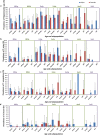Sodalis glossinidius presence in wild tsetse is only associated with presence of trypanosomes in complex interactions with other tsetse-specific factors
- PMID: 30470184
- PMCID: PMC6251152
- DOI: 10.1186/s12866-018-1285-6
Sodalis glossinidius presence in wild tsetse is only associated with presence of trypanosomes in complex interactions with other tsetse-specific factors
Abstract
Background: Susceptibility of tsetse flies (Glossina spp.) to trypanosomes of both humans and animals has been associated with the presence of the endosymbiont Sodalis glossinidius. However, intrinsic biological characteristics of the flies and environmental factors can influence the presence of both S. glossinidius and the parasites. It thus remains unclear whether it is the S. glossinidius or other attributes of the flies that explains the apparent association. The objective of this study was to test whether the presence of Trypanosoma vivax, T. congolense and T. brucei are related to the presence of S. glossinidius in tsetse flies when other factors are accounted for: geographic location, species of Glossina, sex or age of the host flies.
Results: Flies (n = 1090) were trapped from four sites in the Shimba Hills and Nguruman regions in Kenya. Sex and species of tsetse (G. austeni, G. brevipalpis, G. longipennis and G. pallidipes) were determined based on external morphological characters and age was estimated by a wing fray score method. The presence of trypanosomes and S. glossinidius was detected using PCR targeting the internal transcribed spacer region 1 and the haemolysin gene, respectively. Sequencing was used to confirm species identification. Generalised Linear Models (GLMs) and Multiple Correspondence Analysis (MCA) were applied to investigate multivariable associations. The overall prevalence of trypanosomes was 42.1%, but GLMs revealed complex patterns of associations: the presence of S. glossinidius was associated with trypanosome presence but only in interactions with other factors and only in some species of trypanosomes. The strongest association was found for T. congolense, and no association was found for T. vivax. The MCA also suggested only a weak association between the presence of trypanosomes and S. glossinidius. Trypanosome-positive status showed strong associations with sex and age while S. glossinidius-positive status showed a strong association with geographic location and species of fly.
Conclusions: We suggest that previous conclusions about the presence of endosymbionts increasing probability of trypanosome presence in tsetse flies may have been confounded by other factors, such as community composition of the tsetse flies and the specific trypanosomes found in different regions.
Keywords: Glossina austeni; Glossina brevipalpis; Glossina longipennis; Glossina pallidipes; Kenya; Secondary endosymbionts; Trypanosoma brucei; Trypanosoma congolense; Trypanosoma vivax; Vector-pathogen interactions.
Conflict of interest statement
Author’s information
Please note that the data originally appeared in a PhD thesis published by MCh in 2016, under the name Manun Wongserepipatana.
Ethics approval and consent to participate
Authorisation to conduct field studies and tsetse sampling in protected areas was granted by the Kenya Wildlife Service (permits no KWS/BRM/5001). No vertebrate animals or human subjects were used in this study.
Consent for publication
Not applicable.
Competing interests
The authors declare that they have no competing interests.
Publisher’s Note
Springer Nature remains neutral with regard to jurisdictional claims in published maps and institutional affiliations.
Figures




References
-
- Kristjanson PM, Swallow BM, Rowlands GJ, Kruska RL, de Leeuw PN. Measuring the costs of African animal trypanosomosis, the potential benefits of control and returns to research. Agric Syst. 1999;59(1):79–98. doi: 10.1016/S0308-521X(98)00086-9. - DOI
-
- Angara T-EE, Ismail AA, Ibrahim AM. An overview on the economic impacts of animal trypanosomiasis. Global J Res Anal. 2014;3(7):275–276. doi: 10.15373/22778160/July2014/99. - DOI
Publication types
MeSH terms
Grants and funding
LinkOut - more resources
Full Text Sources
Miscellaneous

